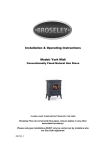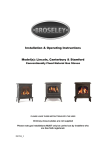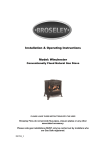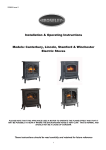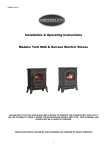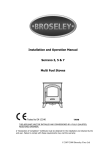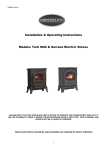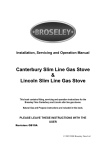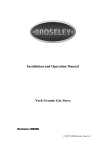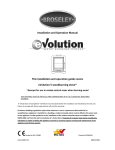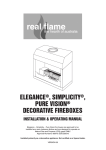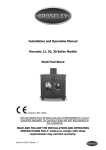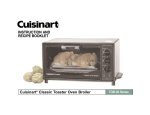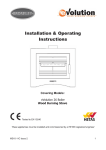Download Broseley Canterbury Technical data
Transcript
Broseley Fires Ltd. Canterbury & Lincoln Balanced Flue Stove (Model : PD-08-002) Remote Control (FITTED AS STANDARD) For use on Natural Gas (G20) at a supply pressure of 20mbar GB and IE. Contact Details: Broseley Fires Ltd Knights Way Battlefield Enterprise Park Shrewsbury SY1 3AB Tel: +44 (0) 1743 461444 Fax: +44 (0) 1743 461446 Email: [email protected] Warranty: In the unlikely event of a defect in materials or workmanship occurring within one year of purchase, please contact the shop from where the appliance was purchased. Any claims under this warranty must be made through the retailer from whom the product was purchased. As the purchaser’s contract of sale is with the retailer, Broseley Fires are unable to enter into discussions with the purchaser until the retailer has inspected any claim and deemed it to be valid. Broseley Fires reserve the right to refuse service or make a charge for any service call, when a defect is due to installation error or misuse. User Instructions. Installation & Servicing Instructions. MUST BE LEFT WITH THE END USER Extended warranty (if purchased) commences after the first year; please see separate registration for further information. Appliance Details: For future reference, please complete the following information at the time of installation. Model and Serial Number details may be found on the data plate as shown. PRODUCT SERIAL NUMBER MODEL: CANTERBURY or LINCOLN FUEL EFFECT: LOG or COAL DATE OF INSTALLATION INSTALLERS DETAILS GAS SAFE REGISTRATION NUMBER DUE DATE OF FIRST SERVICE nd DATE OF 2 SERVICE DATE OF 3rd SERVICE DATE OF 4th SERVICE Page ii Contents 1. GENERAL INFORMATION............................................................................................. 1 2. USER INSTRUCTIONS................................................................................................... 3 2.1. Location of Pilot Burner ................................................................................... 3 2.2. Lighting Procedure .......................................................................................... 4 2.2.1. Lighting Procedure (Manual Control) ......................................................... 5 2.2.2. Lighting Procedure (Remote Control) ........................................................ 6 2.3. Battery Replacement (Remote Control) .......................................................... 8 2.3.1. Handset ..................................................................................................... 8 2.3.2. Receiver Unit ............................................................................................. 8 2.4. Home Improvements ....................................................................................... 9 2.6. Cleaning and Care Instructions ..................................................................... 10 2.6.1. Painted Metal Surfaces ............................................................................ 10 3. INSTALLATION INSTRUCTIONS ................................................................................ 11 3.1. General Safety Requirements ....................................................................... 11 3.2. General Dimensions ...................................................................................... 11 3.3. Flue Options .................................................................................................. 12 3.4. Technical Data .............................................................................................. 12 3.5. Appliance Location ........................................................................................ 13 3.5.1. Clearances to Combustible & Non Combustible Surfaces ......................14 ................................................................... Error! Bookmark not defined. 3.6. Flue Terminal Location .................................................................................. 18 3.7. Flue Components .......................................................................................... 19 3.8. Contents Checklist ........................................................................................ 19 3.9. Installation Procedure ................................................................................... 20 3.9.1. Pre-Installation Procedure ....................................................................... 20 3.9.2. Assembling the cast iron Stove surround and Burner 21 4. 3.9.3. Preparing the installation 3.9.4. 3.9.5. 3.9.6. 3.9.7. 3.9.8. 3.9.9. 3.9.10. 3.9.11. 3.9.12. 3.9.13. 3.9.14. Installation procedure for non combustible walls ......................................... The Gas Supply ....................................................................................... 23 Fuel Effect Layouts .................................................................................. 24 Coal Effect Layout ................................................................................... 25 Log Effect Layout ..................................................................................... 26 Fitting the Glass Panel and Frame .......................................................... 27 Assembly of the cast iron stove components .......................................... 28 Remote control ............................................................................................ Commissioning ........................................................................................ 29 Fitting the Trim ............................................................................................. Instructing the User .................................................................................. 30 21 SERVICING INSTRUCTIONS ....................................................................................... 31 4.1. General Requirements .................................................................................. 31 4.1.1. Cleaning the Fuel Effect, Fire-bed and Combustion Chamber ................ 32 4.1.2. Cleaning Lining Board Panels ................................................................. 32 4.1.3. Care of Lining Panels .............................................................................. 32 4.2. Replacing Parts ............................................................................................. 33 4.2.1. Burner Components Removal and Replacement .................................... 33 4.2.2. Injector Replacement ............................................................................... 33 4.2.3. Control Valve Replacement (Manual Control /Remote Control) .............. 34 4.2.5. Motor Replacement (Remote Control Model) .......................................... 35 4.2.6. Replacing the Receiver (Total Control) ........................................................ 4.2.7. Programming Handset to Receiver (Total Control) ...................................... 4.3. Installation and Operational Troubleshooting .......................................... 36 Page i GUARANTEE.....................................................................................................39 Page ii 1. GENERAL INFORMATION Introduction 1. This appliance is suitable for installation in GB and IE and should be installed in accordance with the rules in force. In GB, the installation must be carried out by a Gas Safe Registered Installer. It must be carried out in accordance with the relevant requirements of the: • • Gas Safety (Installation and Use) Regulations. The appropriate Building Regulations either The Building Regulations, The Building Regulations (Scotland), Building Regulations (Northern Ireland). Where no specific instructions are given, reference should be made to the relevant British Standard Code of Practice (see item 2). In IE, the installation must be carried out by a Competent Person and installed in accordance with the current edition of I.S.813 “Domestic Gas Installations”, the current Building Regulations and reference should be made to the current ETCI rules for electrical installation. On completion of an installation in IE, it is necessary to complete a “Declaration of Conformity” to indicate compliance to I.S.813. 2. In other EC countries, the equivalent rules in force at the time must be used. 3. It is important for correct combustion of this fire, that the imitation fuel is placed in accordance with the instructions given in this and associated booklets. Only approved imitation fuel, available from Broseley Fires Ltd., should be used with this appliance. 4. It is recommended that a fire guard complying with BS 8423 be fitted for the protection of young children, the elderly or infirm. 5. Ensure that curtains are not positioned above the appliance, and there is at least 300mm between the sides of the appliance and any curtains. 6. Clearances to combustible materials must be observed, and only fitted in accordance with the instructions given in this and associated booklets. 7. The user is warned not to remove the glass panel or to disturb the fuel bed. Any servicing of the appliance must be carried out by a Gas Safe registered installer. 8. If any cracks appear in the glass panel, do not use the appliance until the glass panel has been replaced. (by a qualified installer). 9. Ensure that the flue terminal is always kept clear of any obstructions (e.g. shrubs, plants, objects leaning against it, etc.). 10. It is important for the fire to be serviced regularly. An annual service is required. Page 1 Ventilation Requirements 1. This appliance does not require any additional fixed ventilation in the room where it is fitted. It is a balanced flue appliance, whereby the air for combustion is drawn in from the outside, and the products of combustion are evacuated to the outside through a concentric flue duct system. (supplied) 2. In other EC countries, equivalent rules in force at the time of installation must be used. Gas Supply 1. This range of gas fires are only suitable for use with Natural Gas (G20) at 20mbar supply pressure. Conversion to Propane (G31), at 37mbar supply pressure, is not possible. 2. A separate means of isolating the gas supply should be provided near to the appliance this is to facilitate servicing. An isolation valve (with a pressure test point) has been supplied for this purpose. Electrical Supply Not applicable to this range of appliances, as no mains power is required. Efficiency Declaration The efficiency of this appliance has been measured as specified in BS EN 613:2001, and the result is 74.7% (83% net) for Natural Gas. The gross calorific value of the fuel has been used for this efficiency calculation. The test data from which it has been calculated, has been certified by Gastec at CRE Ltd. The efficiency value may be used in the UK Government Standard Assessment Procedure (SAP) for energy rating of dwellings. Hot Surfaces All parts of this appliance, including any handles, get very hot during normal use, they are classed as working surfaces. It is therefore recommended that a suitable fireguard be used for the protection of young children, the elderly and infirm. Page 2 2. USER INSTRUCTIONS 2.1. TO BE LEFT WITH CUSTOMER Location of Pilot Burner The pilot assembly is located just to the right of centre of the appliance, in front of the main burner. The pilot flame can be viewed by looking downwards over the top of the front ceramic (see FIGURE 1). Pilot FIGURE 1. PILOT LOCATION Page 3 2.2. Lighting Procedure Your fire is fitted as standard with a remote control valve. Follow the appropriate operating instructions in the appropriate section. Control Valve Operation + Control Type = REMOTE CONTROL The control valve allows the fire to be lit manually. Once the pilot is lit, the remote control can be used to increase and decrease the gas rate to the burner. By pressing the buttons in short bursts you will be able to adjust the gas rate in small steps. Please read the full instructions for the valve and remote operation below, before attempting to ignite and extinguish your fire. Your appliance can also be controlled manually, using the Gas Rate Adjusting knob. Page 4 2.2.1. 1. Lighting Procedure (Manual Control) From the OFF position, ‘¦’ indicated in FIGURE 3 push the IGNITION KNOB in turn it anticlockwise to the pilot flame position, as shown in FIGURE 3. During this process, the spark ignition will have operated and lit the pilot flame. On ignition of the pilot flame, continue to depress the ignition knob for a further 15 - 20 seconds, then slowly release. The pilot flame should stay alight. If the flame goes out repeat the procedure above to establish the pilot. Ignition knob Gas rate adjusting knob FIGURE 2 – OFF POSITIONS NOTE: No attempt should be made to relight the fire for at least 3 minutes after the pilot flame has been extinguished either intentionally or unintentionally. 2. Once the Pilot is established, turn the IGNITION KNOB further anticlockwise to the main burner operation position, as shown in FIGURE 4. 3. Turn the GAS RATE ADJUSTING KNOB fully anticlockwise (until you reach the stop position) i.e. the maximum gas rate. See FIGURE 5. 4. The main burner will have cross-lit from the pilot and the fire will be at maximum gas rate. 5. Now the gas rate can be adjusted to the desired setting, by turning the GAS RATE ADJUSTING KNOB to any position between the pre-set high and low positions. 6. To switch off the main burner, but leave the pilot alight, turn the IGNITION KNOB to the ‘Pilot burner only Position’ as shown in FIGURE 3. The appliance may be left in this standby mode if desired. 7. To turn the pilot off, turn the Ignition Knob on the control valve fully clockwise to ‘¦’ position. FIGURE 3 – Pilot burner only FIGURE 4 – Main burner operational, but gas flow off FIGURE 5 - Main Burner operational & Maximum Gas Rate Page 5 2.2.2. Lighting Procedure (Remote Control) In order to be able to use the remote control, to adjust the gas rate of the appliance to the desired level, the pilot must first be lit manually. This is described above in 2.2.1 LIGHTING PROCEDURE, MANUAL CONTROL and repeated here, steps 1,2 & 3. Once the pilot is established, the remote control handset is operational, as well as the manual controls on the valve. 1. From the OFF position, ‘¦’ indicated in FIGURE 3, push the IGNITION KNOB in turn it anticlockwise to the pilot flame position, as shown in FIGURE 3. During this process, the spark ignition will have operated and lit the pilot flame. On ignition of the pilot flame, continue to depress the ignition knob for a further 15 - 20 seconds, then slowly release. The pilot flame should stay alight. If the flame goes out repeat the procedure above to establish the pilot. 6. The fire can safely be left in this position at all times, however to prevent unauthorised or accidental use (say by children) it is recommended to turn the IGNITION KNOB to the pilot flame position by turning it 90 degrees clockwise. To turn the pilot off, turn the IGNITION KNOB fully clockwise. NOTE: The clicking sound made by the valve, when using the remote handset, is the operation of the valve clutch. It indicates either the maximum or minimum rotation of the gas rate adjustment knob has been reached. NOTE: No attempt should be made to relight the fire for at least 3 minutes after the pilot flame has been extinguished either intentionally or unintentionally. FULL RATE POSITION MAIN BURNER OFF POSITION PILOT ONLY POSITION 2. Once the Pilot is established, turn the IGNITION KNOB further anticlockwise to the main burner FULL RATE position, as shown in FIGURE 4. 3. From this point onwards, the handset can be used to adjust the gas rate of the appliance to the desired level between the pre-set high and low positions. 4. Using the HANDSET, (as shown in FIGURE 7) By pressing the top and small buttons together (to increase the gas rate) and the lower button only (to decrease the gas rate) the valve can be manipulated to select the desired gas rate between maximum and minimum. By pressing the larger buttons in short bursts you will be able to adjust the gas rate in small steps. 5. To turn the fire off, continuously press the lower big button, until the flame dies down and clicks can be heard from the valve. Release the button as soon as the clicks are heard. The fire is now in ‘pilot only’ position, as shown in FIGURE 3. Page 6 GAS RATE ADJUSTMENT KNOB MAIN BURNER OPERATION IGNITION KNOB FIGURE 6 – Gas Valve Press these two buttons together to increase gas rate Press this button to decrease gas rate FIGURE 7 - Handset Operation This page is intentionally left blank Page 7 2.3. 2.3.1. Battery Replacement (Remote Control) Handset 1. On the reverse of the handset, remove the battery cover by pressing in at the top of the cover and sliding it down. (See FIGURE 8) Press here and slide dow n 2. Remove and unclip the old battery and replace with a new PP3 9V battery. 3. Replace the cover by sliding it back up. FIGURE 8 HANDSET BATTERY REPLACEMENT 2.3.2. Receiver Unit 1. Remove the receiver unit from under the stove. Remove the battery compartment cover by sliding it back. (see FIGURE 9). 2. Remove and unclip the old batteries and replace with new ones, (4 x AA 1.5V) ensuring they are inserted in the correct polarity. 3. Replace the cover on the receiver unit, ensuring that it is securely closed. 4. Return the receiver unit to its original mounting position. FIGURE 9 RECEIVER BATTERY REPLACEMENT With the exception of battery replacement, the receiver / battery holder must be placed on the floor, (hearth) under the appliance. It can be positioned towards the front of the hearth, if you wish to see the ‘handset in use light’ on the front of the unit, or pushed to the back of the hearth, for neatness. Page 8 2.4. Home Improvements NOTICE: Discolouration of wall surfaces near the appliance Generally, heating appliances will create warm air convection currents that will transfer heat to any surface against which they are located. Some soft furnishings (including blown vinyl wallpapers) may not be suitable for use, where they are likely to encounter temperatures above the normal room level. For this reason, the manufacturer’s advice should be sought before using this type of wall covering adjacent to any heating appliance. The likelihood of wall staining, caused from convection air currents, will be increased in areas where high levels of tobacco smoke, or other contaminants, exist. Page 9 2.5. 2.5.1. Cleaning and Care Instructions Painted Metal Surfaces These surfaces should be dusted regularly and any marks removed with a soft damp cloth. Do not leave the appliance wet. A soft brush may be used to clean dust deposits from any cast iron surface. This should be done only when the appliance is cold. Cans of touch-up paint are available to re-paint the cast surfaces of the appliance. Any other maintenance of the product must be carried out by a Gas Safe engineer. 2.5.2 Glass Surfaces Only clean the glass when the appliance is cold and the pilot is not lit. The outside of the glass can be wiped clean with a soft damp cloth. Do not leave the appliance wet. If the inside of the glass is dirty, please get a Gas Safe engineer to investigate, and clean the glass. Page 10 3.0 Installation Instructions for use by the ‘Gas Safe’ engineer THIS APPLIANCE MUST BE INSTALLED AND COMISSIONED BY A ‘GAS SAFE ENGINEER’ Before installation, ensure that the local distribution conditions, identification of the type of gas and pressure, and the adjustment of the appliance are compatible. 3.1 General Safety Requirements Before commencing installation, ensure that the intended installation will comply with details in General Information on Page 1. The installation of the fire should follow the recommendations of the following current British Standards (or equivalent): BS 6891 BS 5440: Pts 1 & 2 IGE/UP/7 Pipe work Installation Flues and Ventilation IGE document for gas installations in Timber Frame Buildings (Available from The Institute of Gas Engineers and Managers) Combustible shelves or materials must only be fitted above the stove as described later in this section. Ensure that curtains are not positioned above the appliance and there is at least 300mm between the sides of the appliance and any curtains. 3.2 General Dimensions FIGURE 10. General Dimensions (image above is of the Canterbury) Height Depth Width Weight (not inc. Ash Lip) LINCOLN CANTERBURY 660mm 280mm 590mm 64kg 655mm 270mm 595mm 66Kg Page 11 3.3 Flue Options FIGURE 11 Flue Pipe and Air Box with terminal (all dimensions in mm) The horizontal length of the ducts is measured from the rear of the outer firebox of the appliance, to the external face of an external wall. The maximum length allowed is 965mm. As the stove must be spaced at least 75mm from the rear wall, the maximum wall thickness that can be accommodated is 890mm. 3.4 Technical Data TECHNICAL DATA Natural Gas (G20) Nominal maximum heat input (hot) 5.1kW (gross) Nominal minimum heat input (hot) 2.3 kW (gross) Setting pressures (cold) Max 10.0 + 0.5 mbar Setting pressures (cold) Min 2.0 + 0.2 mbar Gas Rate 0.486 m³/h Injector Size Multiport 7x ø 0.77mm Gas Inlet Connection 8 mm Compression Pilot Polidoro 440.0333.11 Pilot Injector 2x ø 0.25mm Efficiency 72% (80% net) for Natural Gas (Class 1) Weighted NOx 143mg/kWh (Class 3) Max / Min length of flue duct Standard length of duct supplied 1000mm / 150mm 440mm TABLE 1 Page 12 3.5 Appliance Location The appliance is designed to be fitted through a non combustible back panel mounted on an outside wall. Alternatively the appliance may be fitted into a false chimney breast, a deep rebated fire surround or a redundant fireplace, sited on an outside wall. The appliance may be sited at floor level or as a raised ‘hole in the wall’ installation. In all installations, we recommend a non combustible back panel is fitted behind the appliance, taking into consideration the 75mm clearance requirement between it and the rear of the appliance. A spacer is supplied for this purpose. We do not recommend installing the appliance against a plastered wall without a back panel. The non combustible panel should extend at least 300mm above the top of the stove and be at least the width of the stove, plus 150mm each side. While the temperature of the wall behind and above the stove does not reach a dangerous level, there is still a risk that the plaster may crack, or the wall covering may be marked.The fire must be fitted on a flat, non-combustible base. A non-combustible hearth, with minimum dimensions shown in the figures below, should be provided in front of the fireplace opening where relevant. This is required to protect combustible floor coverings from radiant heat from the fire. If the appliance is to be installed with its base more than 100mm above floor level, the hearth projection in front of the appliance may be reduced to a minimum that is aesthetically pleasing. The different types of wall materials have different installation requirements. If the appliance is to be installed in a timber framed building, the recommendations of IGE/UP/7 Edition 2 Gas installations in timber framed and light steel framed buildings available from the IGEM must be followed. Page 13 3.5.1 Clearances to Combustible & Non Combustible Surfaces 1. Shelves or mantels made from combustible materials should not be placed closer than 300mm above the appliance. 2. Light coloured and resin mantels may discolour in time. The temperature rating of any surround should be checked before use. NOTE: Please see diagrams A & B on pages 15 & 16, to see the temperatures we have recorded, with the appliance at maximum output. These are rises in temperature above the ambient. A B A B C D (above) (each side) (in front) (behind) CLEARANCE TO A COMBUSTIBLE 300 mm 150 mm 50 mm 200 mm CLEARANCE TO A NON COMBUSTIBLE 150 mm 100 mm 50 mm 75 mm The hearth must be made from a suitable, non-combustible material such as board, steel, tiles or glass. The minimum thickness of this material is 12mm. Please ensure that the hearth can accommodate the weight of the appliance and its unsupported flue components. Page 14 ‘Diagram A’ below shows the increase in temperature of the surrounding walls, in degrees Celcius, with the appliance at maximum output. The ambient temperature of the room was 22oC. 100 mm 100 mm 12 16 30 13 13 13 17 15 15 18 18 18 20 21 20 24 25 24 28 30 28 37 40 37 44 55 44 45 132 43 45 46 32 12 113 83 133 660 132 10 19 118 36 14 11 10 9 8 25 147 17 13 21 8 10 590 130 VALVE BODY 10 CONTROL KNOBS 8 DIAGRAM A - increase in temperature of the surrounding walls ‘Diagram B’ below shows the increase in temperature of a decorative shelf, (not supplied) in degrees Celcius, with the appliance at maximum output. The ambient temperature of the room was 24oC. Page 15 D H T DIAGRAM B - increase in temperature of a decorative shelf Temperature Rise (ToC) Height of Shelf above top of Stove mm Page 16 Shelf Depth (D mm) 100 200 200 49 52 300 400 500 600 40 39 32 26 46 42 38 34 Page 17 3.6 Flue Terminal Location The minimum acceptable dimensions from the flue terminal to obstructions and ventilating openings are shown in Table 2 and FIGURE 13. Dimension Value mm Terminal Position A Directly below an opening, air brick, opening windows, etc. 300 B Above an opening, air brick, opening window, etc. 300 C Horizontally to an opening, air brick, opening window, etc. 300 D Below gutters, soil pipes or drain pipes 300 E Below eaves 300 F Below balconies or car port roof 600 G From a vertical drain pipe or soil pipe 300 H From an internal or external corner 600 I Above ground, roof or balcony level 300 J From a surface facing the terminal 600 K From a terminal facing a terminal 600 L From an opening in the car port (e.g. door, window) into the dwelling 1200 M Vertically from a terminal on the same wall 1500 N Horizontally from a terminal on the same wall 300 Table 2 D,E I F B L M C G A I H I FIGURE 12 Page 18 N N H M J K 3.7 Flue Components Ducts Terminal / Air Duct Wall Plate FIGURE 13 PARTS OF THE FLUE KIT 3.8 Contents Checklist Before proceeding with the installation of the appliance, please check the contents of the cartons as follows: Quantity Items in CARTON 1 1 assembly 1 bag Balanced flue gas fire assembly. (with glass fitted) Containing documentation, isolating valve. Quantity Items in CARTON 2 1 box 1 box 1 box 1 1 Quantity 1 Quantity 1 box Quantity 1 box Imitation Coal or Log Pack Front and Rear Ceramic Mouldings Standard flue kit containing 2x 440mm lengths ø100mm flue ducts and an Air Box with Terminal guard. Spacer bracket (to cover visible flue duct behind appliance.) Items in CARTON 3 Terminal Guard Items in CARTON 4 Remote Control Handset and Receiver, 4 off AA Batteries, 1 off PP3 (9V) Battery Items in CARTON 5 Cast iron, decorative stove surround. Page 19 3.9 Installation Procedure Before commencing installation, ensure that the intended installation will comply with details in General Information on Page 1. Carefully unpack the contents of the appliance carton and check them against the checklist given on the previous page. 3.9.1 Pre-Installation Procedure Appliance 1. Unpack the Balanced flue gas fire assembly from its carton. 2. Using a suitable 7mm socket remove the 14off glass frame retaining nuts and lift off the glass frame. Place them in a safe place. Retaining nuts FIGURE 15 GLASS FRAME RETAINING NUTS 3.9.2 Assembling the cast iron Stove surround and Burner A QUICK OVER-VIEW. The gas fire burner assembly is separate from the decorative cast iron casting. The base casting will require the feet to be bolted on, then the burner assembly is bolted to the base casting. Once the burner assembly is mounted on the base, this sub assembly can be installed as the ‘gas fire’, before the final decorative casting is fitted to the installed appliance. Please read the step by step instructions below. 1 Remove the cast iron, decorative stove surround from its packaging. 2 Some models will have a steel transit bar supporting the side castings of the appliance. If it is present, it will need removing before assembling the burner. 3 Remove the side and front castings (together) from the base casting, by undoing the bolts holding them to the base. 4 Fix the 4 legs onto the base casting, using the bolts and washers supplied. 5 Fix the supplied brackets (2off) to the side of the balanced flue burner box, using the self tapping screws provided. See Fig. 16 - P1. There are different bracket positions depending on the model. Position ‘A’ Is for The Lincoln and The Stamford, Position B is for The Canterbury. Once the two brackets have been screwed to the side of the burner assembly, lift the burner assembly onto the base casting, locating the brackets with the four holes in the base casting. Use the 4off bolts and washers provided to secure the burner assembly to the base casting. See Fig. 16 - P2. below. Page 20 P1 - self tapping screws Position A Position B P2 - bolts & washers REMOTE CONTROL VALVE FIGURE 16 6 Once the Balanced flue gas fire assembly is bolted to the base casting (as shown above), the next stage is to prepare the fireplace, ready for the installation of this ‘sub assembly’. 3.9.3 Preparing the Installation General Notes 1. Please attempt to keep the hole sizes for the flue ducts as close as possible to the minimum dimensions, shown in Figure 17 below. This will keep the installation tidy, reducing the need for excessive use of sealant afterwards. 2. Ensure any damp course, electrical wiring, or any pipe work within the wall, is not going to be affected by the installation. 3. Any gas pipe concealed in the wall, floor or cavity must be continuous and enclosed within a gas tight sleeve. (Gas Safety (Installation & Use) Regulations: 1998). 4. Ensure that the chosen position for the appliance will comply with the requirements detailed in Section 3.5 5. 3.9.4. Installation Procedure for Non Combustible Walls. 1. Place the appliance in position with the spacer bracket touching the ‘non combustible wall’ immediately behind the appliance. Using the leg adjusting screws, adjust the individual leg heights to level the appliance. materials within the installation, are removed and replaced with Rockwool® or equivalent material, to the correct thickness. 4. Replace the appliance back in position. 2. Mark the wall for the centres of the two flue ducts. Lift the appliance clear, ready for the drilling operation. 3. Drill the two Ø125mm holes for the flue ducts in the previously marked positions and drill and plug the four holes for the wall plate fixings. Ensure that any cavity wall insulation, or other combustible Page 21 1. Take the flue ducts supplied and push them through the wall, onto the flue duct spigots that are mounted on the rear of the appliance. Make sure they are fully pushed home. With the appliance spaced correctly against the wall (using the spacer supplied) inside the property, go outside and mark both flue ducts at 10mm away from the external wall surface. (Note; Two 440mm lengths of Ø100mm tube are supplied as standard. This is sufficient for most inset installations. Longer lengths of flue duct, up to 1000mm can be supplied. This is also the maximum length of flue duct that is permitted to be used.) 2. Withdraw both flue ducts and cut them squarely at the mark made in the above paragraph (10mm away from the external wall surface) 3. Deburr the ends of the tube. 4. Paint any exposed area of the upper flue duct with black, high temperature paint. 5. Apply fire cement around each of the flue duct spigots on the rear of the appliance. 6. Push the two lengths of flue duct through the wall and onto the duct spigots on the rear of the appliance. Make sure the tubes are pushed fully home, right up to the firebox. Turning them clockwise will assist this. Page 22 7. Take the Air Box assembly and unscrew the painted outer cover and terminal from the wall plate. 8. Engage the flue ducts from the appliance into the wall plate. 9. Mark the four fixing positions for fixing the wall plate in position onto the wall and remove the wall plate. Drill and plug the marked positions. The diagram above shows the dimensions of the wall plate. 10. Apply fire cement around the two duct spigots on the inside of the wall plate. 11. Engage the duct spigots with the two tubes from the rear of the appliance. The duct spigot on the outside of the wall plate must be uppermost. 12. Screw the outer cover and terminal back onto the wall plate. Apply a bead of mastic around the periphery of the wall plate to prevent water ingress. 13. If the centre of the terminal is within 2 metres of the ground or a balcony the terminal guard (supplied) must be fitted. 14. Push the wall plate fully home and fix in position with appropriate screws. 15. Fill the gaps between the flue ducts and the wall with mineral wool, Rockwool® or equivalent material. 3.9.5 The Gas Supply 1. The gas supply can be fed to the appliance from underneath. Care should be taken to sleeve the pipe when passing through masonry. 2. An 8mm isolating valve (with a pressure test point) has been supplied with this fire to facilitate isolation of the fire during servicing. 3. The gas supply to the fire must be carried out using rigid or semi-rigid tubing. 4. Connect the outlet of the isolating valve to the inlet of the control valve on the fire tray. The outlet on the isolating valve is the one nearest to the pressure test point. FIGURE18 ISOLATING VALVE WITH TEST POINT 5. Once the gas connection has been completed, follow the instructions for the correct positioning of the logs or coals, in Fuel Effects Layout section. (next page.) Page 23 3.9.6 Fuel Effects Layout It is recommended that the imitation fuel be left alone once the desired flame pattern has been achieved. Constant moving of the imitation fuel will cause the fuel to disintegrate and/or cause discolouration. Due to the nature of this appliance, any ‘work’ regarding the Fuel effect layout should only be carried out by a Gas Safe Registered Installer Refractory Ceramic Fibres (RCF) advice: This product may use Components (Fuel Effects & Ceramic backs) containing Refractory Ceramic Fibres (RCF), which are man-made, vitreous silicate fibres. Excessive exposure to this material may cause irritation to eyes, skin and respiratory tract. Therefore, during installation and servicing, we recommend that you use a HEPA filtered vacuum to remove any dust and soot accumulated in and around the fire before and after working on the fire. This is to ensure that the release of fibres from these RCF articles is kept to a minimum. We recommend that you should follow the normal hygiene rules of not smoking, eating or drinking in the work area. When replacing Components containing Refractory Ceramic Fibres (RCF), we recommend that the replaced items are not broken up, but are sealed within heavy duty polythene bags and clearly labelled as RCF waste. RCF waste may be disposed of in suitably licensed landfill sites. WARNING: Do not touch the fire when it is alight. The fire will remain very hot for a while after extinguishing, as will the artificial coals and logs. Page 24 3.9.7 Coal Effect Layout The COAL SET comprises of the following: PART QUANTITY Front Ceramic 1 Rear Ceramic 1 Ceramic Coals 12 Ensure that the flat faces of the coals are facing down, or into the fire, and there are enough gaps between the coals. Figure 19 – Rear Ceramic Proceed with the layout as follows: 1. Position the rear burner ceramic in position, behind the rear burner flange, as shown in Figure . 2. Gently lift the rear ceramic so that the front ceramic slides in easily. Place the front burner ceramic in its support, in front of the burner, as in FIGURE 20. 3. Place three coals across the top of the rear ceramic, as shown in Figure . Ensure that the flat faces of the coals are facing downwards, into the fire. These coals should touch each other, and the rear face of the firebox. 4. Place five coals across the front of the fire. These coals should rest partly on the front ceramic (in the shallow cut outs) and partly on the protrusions from the base of the rear ceramic. The furthest left hand coal, and the two furthest right hand coals should be angled front to back. The other two coals should be angled across the fire, left to right. (see Figure). Figure 20 – Front Ceramic Figure 21 – Rear Coals 5. Place four coals bridged between the rear and the front coals (see Figure ). 6. Ensure that the flat faces of the coals are facing downwards, into the fire. Figure 22 - Front Coals It is recommended that the fuel effect be left alone once the correct positioning and desired flame picture has been achieved. Constant moving of the fuel effect causes the fuel effect to disintegrate and/or cause discolouration. Figure 23 – Top Coals Page 25 3.9.8 Log Effect Layout The LOG SET comprises of the following: QUANTITY PART Rear Ceramic Front Ceramic Straight Logs Large ‘Y’ Log Small ‘Y’ Log Stubby ‘Y’ Log 1 1 2 1 1 1 Figure 25 Proceed with the layout as follows: 1. Position the rear burner ceramic behind the rear burner flange, see Figure 24 2. Place the front burner ceramic in its supports in front of the burner as in Figure 25. Manipulate the rear ceramic so that the front ceramic slides in easily. 3. Place one straight log on the rear ceramic, across the rear right hand side, with the burnt end facing right. Place the other straight log on the left hand side, with the burnt end facing front, bridging between the front and rear ceramic (see Figure ) 4. Place the large ‘Y’ log across the front ceramic with one of the legs of the ‘Y’ resting on the straight log at the back (see Figure 14). Figure 26 Figure 14 5. Proceed with placing the small ‘Y’ log, bridging between the front and rear ceramic and behind the front ‘Y’ log, as in Figure 15. 6. Finally place the stubby ‘Y’ log in the left hand rear corner (see Figure 16). 7. It is recommended that the fuel effect be left alone once the desired flame picture has been achieved. Constant moving of the fuel effect causes the fuel effect to disintegrate and/or cause discolouration. Figure 15 Figure 16 Figure 24 Page 26 Retaining nuts 3.9.9 Fitting the Glass Panel and frame 1. Refit the glass panel/frame to the front of the appliance, taking care not to move any of the ceramic logs or coals. Secure glass in position using the previously removed nuts. (see FIGURE 30) 2. To ensure a good seal tighten the nuts in a diagonal sequence a few turns at a time. Retaining nuts 3. Fully tighten all the retaining nuts. Do Not use power tools to tighten the nuts. 4. Do not over-tighten the nuts and ensure that the seal behind the frame is gas tight. FIGURE. 30 GLASS FRAME RETAINING NUTS 3.9.10 Assembling the Cast Iron Stove Components. Now the burner sub assembly has been installed as the ‘gas fire’, the final decorative casting can be fitted to the installed appliance. Please read the step by step instructions below. 5. Carefully lift and locate the side and front castings, as one assembly, to the base casting. This is a snug assembly and care should be taken not to rush this procedure. Once the side and front casting assembly is located squarely to the base casting, secure it using the 2off bolts and washers provided. These locate from underneath, through the clearance hole in the base casting, and screw into the threaded tongue on the bottom of each side panel. See figure 31. FIGURE 31. SIDE CASTING, THREADED TONGUE. 6. The clearance hole in the base casting can be seen in the Figure 16, (on page 18) 7. Locate the lid squarely onto the stove body. The lid should locate onto the top of the stove but does not need to be fixed in position. Page 27 3.9.11 Continuation of Installation - Remote Control 1. Unpack the box containing the Receiver and the Hand Set. 2. Fit four AA (1.5V) batteries into the receiver unit and one PP3 (9V) battery into the hand set (transmitter) 3. Feed the cable from the receiver unit to the spade terminals on the control valve motor. Keep the cable clear of the underside of the combustion chamber, failure to do so may cause heat damage to the cable. The cable connectors must be matched to the appropriately sized spade connector, one large, one small. (see Figure 32). 4. This ensures the correct rotation of the motor when the up or down button is pressed on the handset. 5. Test the operation of the drive motor using the hand set as per Users Instructions Section 2.2.2 Lighting procedure (Remote Control) SPADE CONNECTIONS CONTROL VALVE ISOLATING VALVE WITH TEST POINT + FIGURE 32 CONTROL & ISOLATING VALVE Page 28 3.9.12 Commissioning 1. Turn on the gas supply to the fire and purge the gas line. Check all the gas joints for gas soundness. 2. Connect a pressure gauge to the pressure test point on the isolating valve. 3. Ignite the pilot in accordance with the User Instructions. 4. Set the controls to give full gas rate at the main burner. Check that the main burner cross lights smoothly. 5. Ensure that the pressure at the pressure test point is 20 ±1.0mbar for natural gas. 6. If the correct pressure cannot be achieved, then some potential causes of low pressure are: a) Supply pipes are not of large enough diameter. b) The supply pipes are kinked, blocked or partially blocked. c) Restriction at isolation valve. the appliance 7. Set the control to the low rate position (small flame image) and ensure that the flames reduce in size. 8. Turn the fire off. 9. Replace the screw in the pressure test point. Page 29 3.9.13 Instructing the User The installer must hand over these instructions to the user and explain how to operate this fire, stressing the importance of having the fire checked and serviced regularly. An annual service is recommended. Page 30 It is mandatory as part of the gas installation that the installer instructs the user on the correct operation and care of their appliance. 4 SERVICING INSTRUCTIONS 4.1 General Requirements All repairs and servicing must be carried out by a qualified registered gas installer (e.g. member of Gas Safe Register in GB) in accordance with the current Gas Safety (Installation and Use) Regulations and these instructions. Before any servicing is carried out ensure that the gas supply is turned off. Always check for gas soundness after dismantling or exchange procedures. CAUTION: Ensure that the appliance is off (including the pilot light) and has completely cooled (off for at least 2 hours) before carrying out any cleaning or maintenance. RCF Advice: This product may use Components (Coals, Pebbles & Ceramic backs) containing Refractory Ceramic Fibres (RCF), which are man-made vitreous silicate fibres. Excessive exposure to this material may cause irritation to eyes, skin and respiratory tract. Therefore during installation and servicing we recommend that you use a HEPA filtered vacuum to remove any dust and soot accumulated in and around the fire before and after working on the fire, to ensure that the release of fibres from these RCF articles is kept to a minimum. We recommend that you should follow the normal hygiene rules of not smoking, eating or drinking in the work area. When replacing Components containing Refractory Ceramic Fibres (RCF), we recommend that the replaced items are not broken up, but are sealed within heavy duty polythene bags, and clearly labelled as RCF waste. RCF waste may be disposed of in suitably licensed landfill sites. Most servicing operations on this appliance will require the cast iron stove body panels to be removed. Refer to the appropriate section for details of how this is done. Page 31 4.1.1 Cleaning the Fuel Effect, Fire-bed and Combustion Chamber 1. Remove the cast iron top, sides and front of the stove. 2. Remove the glass door panel and place it in a safe place. 3. 4. 5. Carefully ceramics and rear soot can brush. remove all the fuel bed from the fire. Lift out the front ceramics. Any debris/dust or be brushed off using a soft Remove the two screws securing the burner and gently lift it out of the appliance. Clean the burner slot with a brush and check that the venturi is clear. Check that the electrode sparks across the gap when the ignition knob is operated. 6. Use a vacuum cleaner to remove any fluff or lint on the base of the combustion chamber. 7. Refit the burner and secure in place using the previously removed screws. 8. Replace the front and rear ceramics and relay the fuel bed as described in the appropriate fuel bed layout sections. 9. Refit the glass/frame and secure in place using the previously removed nuts. Refit the infill plate. 10. The flue can be inspected and cleaned by removing the terminal/ outer cover. 11. Re-assemble the cast iron sides, front and top of the stove. 4.1.2 Cleaning Lining Board Panels Any soot or dust marks on the side, top or rear panels can be cleaned by lighting dusting them with a very soft brush. NOTE: Any attempt to clean the lining panels using an alternative method, will result in irreparable damage leading to a replacement being required. 4.1.3 Care of Lining Panels The lining panels on this appliance must NOT be sprayed with any type of solvent-based high temperature paint. The very high temperatures produced within the appliance will cause the paint to bubble and/or burn off rendering the fireback looking unsightly. Minor surface scuffs may be treated using a water based touch up stain available at Magiglo fire retailers. Extreme care should be taken when handling and installing products containing ceramic fibre board, so as not to cause damage. Page 32 4.2 Replacing Parts For any spare parts that are required, please contact either your supplier or the manufacturer directly. You will need the model name i.e. model number, the gas type, the type of control and serial number. Servicing and repairs to your appliance must be carried out by a Gas Safe engineer. Only approved parts must be used. Isolation of the appliance from the gas supply will be necessary, before any ‘work’ is carried out. 4.2.1 Burner Components Removal and Replacement For ease of access to all the burner components, we recommend removal of the entire burner assembly from the decorative cast iron stove surround. Please inspect the condition of any seals or spacers before re-assembly and replace if necessary. NOTE: If at any time the pilot assembly is removed or replaced, the spacer should be replaced as well. Section 3.9 describes the installation procedure of the burner assembly into the decorative cast iron stove surround. Reverse this procedure till you have easy access to the component you wish to service or replace. 4.2.2 Injector Replacement 1. Remove the cast iron top, sides and front of the stove. 2. Remove the glass door panel, the fuel bed components and the front and rear ceramics. 3. Lift out the top lining board, followed by the two sides and the back. 4. Remove the main burner. See FIG. 31 5. Grip the injector nose whilst undoing the injector tube nut. Burner s upport brac k et Inj ec tor Sec uri ng Inj ec tor tube Nuts nut 6. Unscrew the outer injector securing nut. Unscrew the self tapping screws, holding the burner support bracket in place. Lift away the support bracket. 7. Remove the injector and replace it with the new one. Change over the rear securing nut. 8. Replace the burner support bracket and secure with the four self tapping screws. Replace the outer injector securing nut and tighten. Grip the injector nose and tighten the tube nut, making sure that the injector is correctly aligned. 9. Replace all the other components. Valv e Brac k et fix ing s c rews FIGURE 30. INJECTOR & VALVE DETAIL Page 33 4.2.3 Control Valve Replacement (Manual Control /Remote Control) For ease of access to all the burner components, we recommend removal of the entire burner assembly from the decorative cast iron stove surround. Please inspect the condition of any seals or spacers before re-assembly and replace if necessary. Burner Securing Screws 1. Once the burner assembly is safely removed, remove the spark lead from the electrode on the pilot burner. 2. Remove the 4off spade connections from the motor. The receiver is connected to the other end, located on the hearth, under the appliance. 3. Disconnect the thermocouple from the rear of the valve. Unscrew the gas connections from the valve. 4. Remove the old valve from the mounting bracket and replace with new one. If necessary, remove the tube adaptors from the old valve and fit them to the new valve. 5. Remake the gas connections. 6. Remove the valve cover by removing the securing screw and levering out the cover through the slot on the opposite side using a small screw driver. SPADE CONNECTIONS CONTROL VALVE FIGURE 31 BURNER SECURING SCREWS 7. Transfer all the tubing on the old valve to the new one, ensuring that the tubing positions are the same as before. Tighten all connections. 8. Refit the rest of the components in reverse order. 9. Reconnect the thermocouple to the rear of the valve, taking care not to kink the pipe. 10. Refit the valve in reverse order. 11. Refit the HT lead and remake all the gas connections. ISOLATING VALVE WITH TEST POINT PILOT ASSEMBLY SPARK LEAD (HT) FIGURE 32. REMOTE CONTROL & ISOLATING VALVE Page 34 4.2.4 Motor Replacement (Remote Control Model) For ease of access to all the burner components, we recommend removal of the entire burner assembly from the decorative cast iron stove surround. Please inspect the condition of any seals or spacers before re-assembly and replace if necessary. 1. Remove the batteries from the receiver unit to prevent the risk of short circuit. 2. Remove the two motor connection tags from the valve. HT Lead Valve Cover Securing Screw FIGURE 17. REMOTE CONTROL VALVE 3. Remove the valve cover securing screw. 4. Unclip the valve cover from the valve on the right hand side by inserting a very small screwdriver in the slot on the right hand front of the cover and pull out the cover. 5. Turn the gas rate adjusting knob fully anticlockwise and gently manipulate the motor free from the valve (see note). FIGURE 18 6. Replace with new motor ensuring that the motor is hooked into the right hand lug. Drive Motor 7. Replace the cover and secure with the screw. 8. Remake the motor connections ensuring that the large tag is fitted to the large spade (top connection) and vice versa. 9. Replace the batteries correct polarity. ensuring the 10. Operate the handset to check the operation of the motor. Gas Rate Adjusting Knob FIGURE 19 Note: Operating the gas rate adjusting knob manually will cause the motor clutch to operate. This is normal and will not affect the valves’ operation. Page 35 4.3 Installation and Operational Troubleshooting The table below is intended for problems related to the fire and its gas controls. It is a guide only and does not take into account every eventuality. Servicing must be carried out in accordance with the current Gas Safety (Installation and Use) Regulations, by a competent person. It is recommended that the purchaser seek the advice of the original installer in case of encountering any problems. Symptom Cause Remedy a) Electrode cracked or broken Replace electrode b) HT lead shorting out Establish where spark is occurring and insulate or reroute lead accordingly. c) Faulty spark generator Replace valve d) HT lead disconnected from electrode Re-connect HT lead to electrode Piezo operates normally but pilot will not light a) No gas supply Check isolation valve/supply b) Pilot jet blocked Clean pilot jet Pilot lights, but goes out when control is released a) Loose thermocouple connection at control valve end Remake thermocouple ensuring the connection is firm b) Faulty Thermocouple Replace thermocouple d) Thermocouple not fully inserted into pilot burner Loosen thermocouple clamp nut and push thermocouple fully upwards a) Gas supply partially blocked b) Too many bends on gas inlet Increase diameter and/or pipe reduce the number of bends c) Pilot jet partially blocked Clean pilot jet. d) Restriction at Isolation valve Ensure valve is fully open and that internal diameter is sufficient and free from grease No spark appears at the electrode Pilot and main burner go out when control is set to high position Locate restrict and remove faulty section Warning: If you are in any doubt about the clearance of fumes, you must stop using the appliance immediately and seek expert advice. Do not use appliance until the fault has been rectified. Page 36 Remote Control Symptom Cause Remedy Main burner will not come on when required even though the drive motor is heard to be operating Ignition knob incorrectly set Set the ignition knob at the 9 o’clock position. Motor not functioning when buttons are pressed a) Flat hand set battery (Remote Control) Replace battery (1 X PP3) b) Flat batteries in receiver unit (Remote Control) Replace all 4 AA batteries c) Flat batteries in battery holder (Trim Switch and Optimum Control) Replace all 4 AA batteries Remote Control will turn fire off but will not turn on Incorrect hand set operation Ensure two buttons are pressed to turn on NOTE: For any spare parts that are required, please contact either your supplier or the manufacturer directly. You will need the model name i.e. Model Number, the gas type, the type of control and serial number. Only approved parts should be used. Page 37 Guarantee Dear Customer, Your gas appliance, when installed in accordance with the installation instructions and operated in accordance with these instructions, should provide many years of safe and efficient operation. We thank you for purchasing our product and trust it will provide excellent service. This appliance carries a guarantee of 1 year. The consumable components of this appliance are guaranteed for one year. We agree to repair free of charge or, at our option, replace the appliance or part thereof, which may prove to be defective within the guarantee period. In the unlikely event of a defect in materials or workmanship occurring within one year of purchase, please contact the shop from where the appliance was purchased. Any claims under this warranty must be made through the retailer from whom the product was purchased. The purchaser’s contract of sale is with the retailer, not Broseley Fires. We (Broseley Fires) are unable to enter into discussions with the purchaser, until the retailer has inspected any claim and deemed it to be valid. Broseley Fires reserve the right to refuse service or make a charge for any service call, when a defect is due to any of the following issues which will void your Guarantee. The guarantee is void if: • • • • • • The appliance is not installed and operated in accordance with our instructions; or The appliance is not serviced, by a Gas Safe registered engineer, annually; or Repairs of modification have been carried out by the purchaser or any third party not authorized by us; or The appliance has been misused or accidentally damaged; or Damage is due to ‘fair wear and tear’; or The appliance or defective component(s) are not returned to us, prepaid postage. The rights given in this guarantee are limited to the UK mainland and are in addition to any to which you may have a statutory entitlement. Please retain your purchase receipt, we may need to see this in the event of a claim under warranty. Page 38 This page is left intentionally blank Page 39 Contact Details: Broseley Fires Ltd Knights Way Battlefield Enterprise Park Shrewsbury SY1 3AB Tel: +44 (0) 1743 461444 Fax: +44 (0) 1743 461446 Email: [email protected] This product is protected by UK patents 2193802, 2240620 and 2256920 Other Patents Pending MFTBA












































